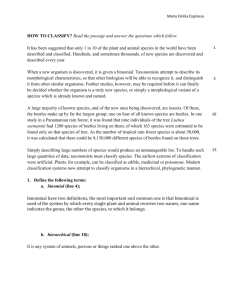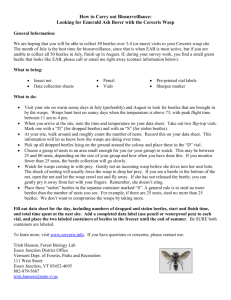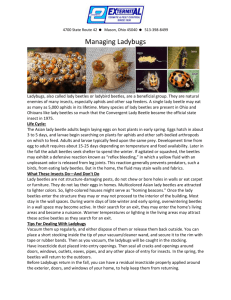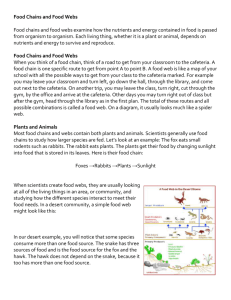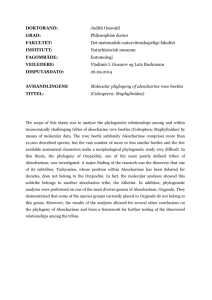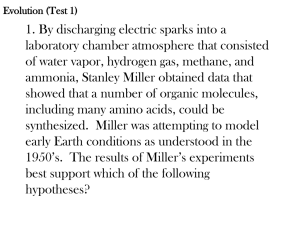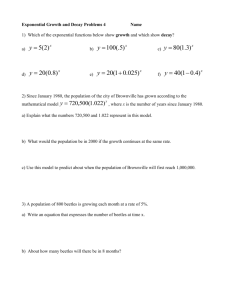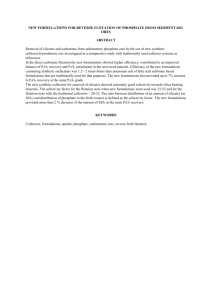Biorational Pesticides for Cut Flower Production
advertisement
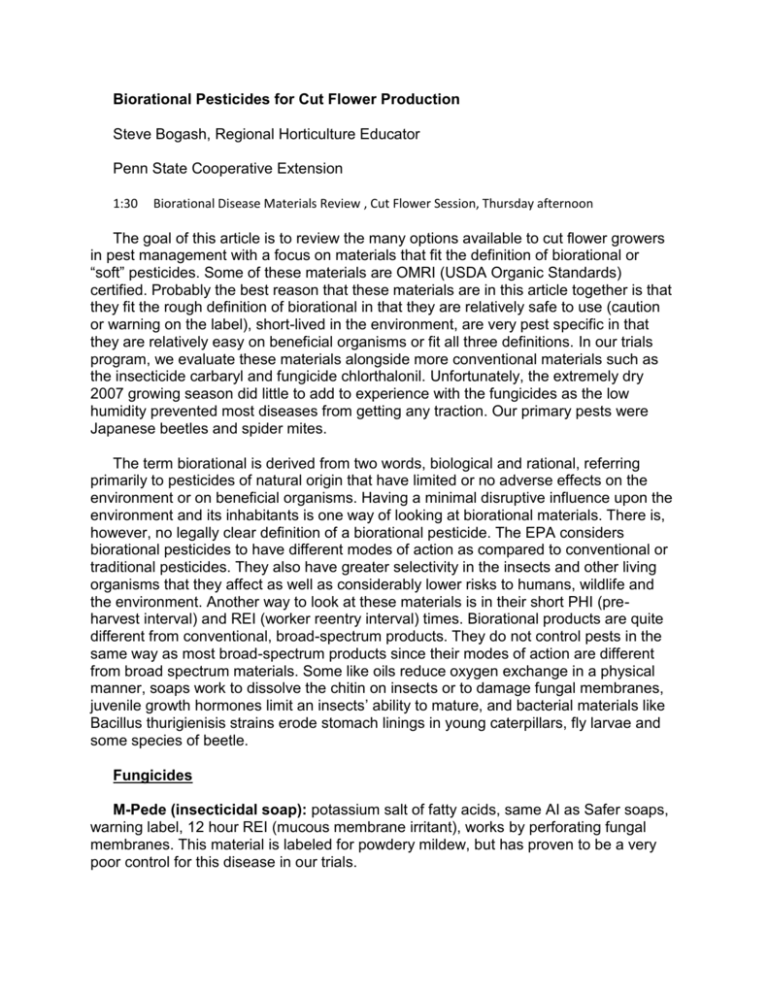
Biorational Pesticides for Cut Flower Production Steve Bogash, Regional Horticulture Educator Penn State Cooperative Extension 1:30 Biorational Disease Materials Review , Cut Flower Session, Thursday afternoon The goal of this article is to review the many options available to cut flower growers in pest management with a focus on materials that fit the definition of biorational or “soft” pesticides. Some of these materials are OMRI (USDA Organic Standards) certified. Probably the best reason that these materials are in this article together is that they fit the rough definition of biorational in that they are relatively safe to use (caution or warning on the label), short-lived in the environment, are very pest specific in that they are relatively easy on beneficial organisms or fit all three definitions. In our trials program, we evaluate these materials alongside more conventional materials such as the insecticide carbaryl and fungicide chlorthalonil. Unfortunately, the extremely dry 2007 growing season did little to add to experience with the fungicides as the low humidity prevented most diseases from getting any traction. Our primary pests were Japanese beetles and spider mites. The term biorational is derived from two words, biological and rational, referring primarily to pesticides of natural origin that have limited or no adverse effects on the environment or on beneficial organisms. Having a minimal disruptive influence upon the environment and its inhabitants is one way of looking at biorational materials. There is, however, no legally clear definition of a biorational pesticide. The EPA considers biorational pesticides to have different modes of action as compared to conventional or traditional pesticides. They also have greater selectivity in the insects and other living organisms that they affect as well as considerably lower risks to humans, wildlife and the environment. Another way to look at these materials is in their short PHI (preharvest interval) and REI (worker reentry interval) times. Biorational products are quite different from conventional, broad-spectrum products. They do not control pests in the same way as most broad-spectrum products since their modes of action are different from broad spectrum materials. Some like oils reduce oxygen exchange in a physical manner, soaps work to dissolve the chitin on insects or to damage fungal membranes, juvenile growth hormones limit an insects’ ability to mature, and bacterial materials like Bacillus thurigienisis strains erode stomach linings in young caterpillars, fly larvae and some species of beetle. Fungicides M-Pede (insecticidal soap): potassium salt of fatty acids, same AI as Safer soaps, warning label, 12 hour REI (mucous membrane irritant), works by perforating fungal membranes. This material is labeled for powdery mildew, but has proven to be a very poor control for this disease in our trials. Phostrol / ProPhyte / Topaz /Excell O:(phosphonic acid): Depending on the specific material, these phosphonic acid products come formulated as both a salt and a fatty acid. Field trials indicate that the fatty acid formulations are less likely to be phytotoxic on sensitive plants. These products have done an excellent job controlling downy mildew on a wide variety of plants. Although not a control for phytopthora blight, many growers have found these products to inhibit the spread of this disease if applied preventatively and regularly to young actively growing plants. Plant Shield and Root Shield (Tricoderma hazardium T-22): Excellent preplant inoculant. This specific fungus develops a symbiotic relationship with plant roots and will continue to grow with the plant. Preventative for Rhizoctonia, Pythium and Fusarium. Some researchers report that the combination of this inoculant with bacterial inoculants such as B.subtillus will enhance preventative activity. REI=0, some compatibility with other fungicides. Kocide 2000, TennCop, Champ, Phyton 27 (various formulations of Fixed Copper): Coppers have long been used as a fungicide and bactericide and are an important component of any disease management program. Of these formulations only Champ currently has an OMRI label. The primary drawback of coppers is the tendency to stain leaves and flowers. We’ve gotten good control of mildews, blights and bacterial diseases with various copper formulations. However, powdery mildew can readily overwhelm coppers when the weather conditions are favorable and inoculum is present. Yellow Jacket , Micronized Sulfur and others (sulfur): many OMRI labeled formulations. Seek water dispersable formulations for sprays. Excellent for powdery mildew control, but crops vary widely in tolerance. There is variable tolerance by both crop and cv. Also, phytotoxicity is very temperature dependant, as the weather gets hotter, so does the likelihood of phytotoxic damage. Insecticides: M-Pede (Insecticidal Soap): potassium salt of fatty acids, same AI as Safer soaps, warning label, 12 hour REI (mucous membrane irritant), excellent on soft bodied pests (aphids, whiteflies…) good activity on many insects in juvenile stages, some plant sensitivity (see label), we been getting excellent spider mite control at highest labeled rate, but very poor control at anything below that rate. SpinTor / Entrust / Conserve (spinosad): All of these products are derived from the fermentation of Saccharopolyspora spinosa, a naturally occurring soil bacteria. When this bacterium is grown in fermentation culture, it releases a group of related metabolites called spinosyns. Two of the spinosyns (spinosyn A and spinosyn D) are made into the products called SpinTor, Entrust and Conserve. Entrust and Conserve have been formulated to meet OMRI standards. Spinosad is a broad spectrum insecticide providing control of Lepidoptera larvae (caterpillars), beetles, leafminers, thrips, and psyllids. It is also labeled for suppression of flea beetles and grasshoppers. The current label covers: asparagus (asparagus beetles), garlic, leeks, onions, cole crops, sweet and popcorn, cucurbits, peppers, tomatoes, eggplants, tomatillo, herbs, leafy vegetables, legumes, mint, potatoes, sweet potatoes, beets, strawberries, and most root vegetables. Spinosad is considered safe when used as directed for beneficial insect populations, but is toxic to bees. Do not use acidifying buffering agents or adjuvants with any of the spinosyn-based materials as they break down quickly due to alkaline hydrolysis. REI is 4 hours and PHI is 1-3 days for most plants, but varies widely with the specific crop. Aza-Direct (specifc neem oil extract):MOA’s: IGR, repellant and anti-feedant. REI 4 hours. Controls: aphids, weevils, Japanese beetles, borers, stink bugs, caterpillars, flies, leafhoppers, whiteflies, mealy bugs, scale, thrips…This material provided nearly as good control of Japanese beetles as carbary, but like carbaryl is toxic to bees. Neem oil (refined oil extract from Azadirachta indica) Trilogy, Triact, Bioneem: Raw neem oil contains over 25 active ingredients. Both contact and systemic activity, low mammalian toxicity. Considered safe with many beneficial insects, but formulations vary widely in bee toxicity. Some anti-feedant activity on Japanese beetles, but did not provide enough for growing high quality flowers. We’ve found this to be a good general purpose fungicide perhaps usable as a biorational substitute for chlorthalonil. PyGanic (pyrethrum): OMRI labeled pyrethroid, extremely broad label, rapid knockdown of most insect pests (although some will be back up). BotaniGard ES (beauveria bassiana strain GHA): This is a mycoinsecticide or fungal extract. REI :4 hours. Compatible with most other insecticides and some fungicides. Controls: whiteflies, aphids, thrips, psyllids, mealybugs, scarab beetles, lace bugs, weevils. Gnatrol (specific strain of Bt (Isrealiensis): Very specific activity on fungus gnat larvae. Requires regular application to the top 1” of potting media for 2-3 weeks to clean up a problem due to continued egg laying of active adults. Primarily used in potting media in greenhouse. This material provides no control for Shore flies. Fungus gnats can only controlled keeping up the applications until all of the adults have died of old age and there are no more developing larvae unless a knock-down material is used to kill the adults. Molluscicides: Sluggo and Escar-go (Iron phosphate): The long time standard in slug control in greenhouses and outdoor plantings has been metaldehyde which is marketed under many brands. Unlike metaldehyde, iron phosphate is considered relatively benign in the environment while still providing high levels of slug control. These are pelleted bait products that draw slugs to feed. Unlike metaldehydes, iron phosphate is not toxic to mammals and birds. REI and preharvest interval = 0. This material has worked extremely well in the trial gardens and for those growers that have used it in commercial applications.
